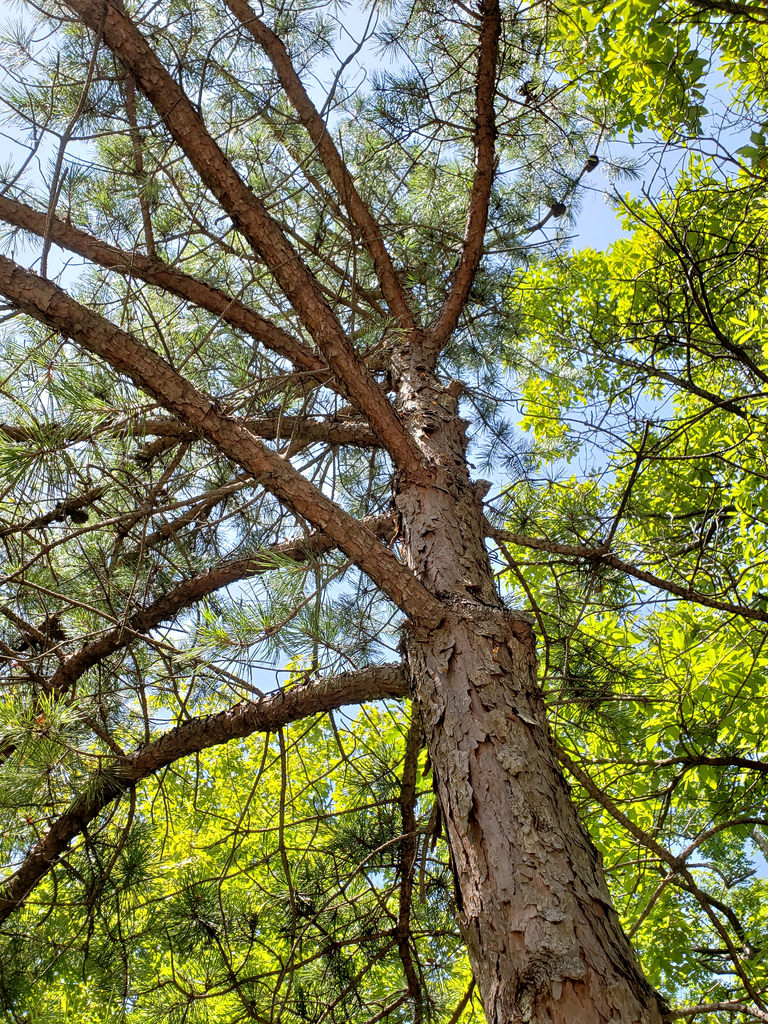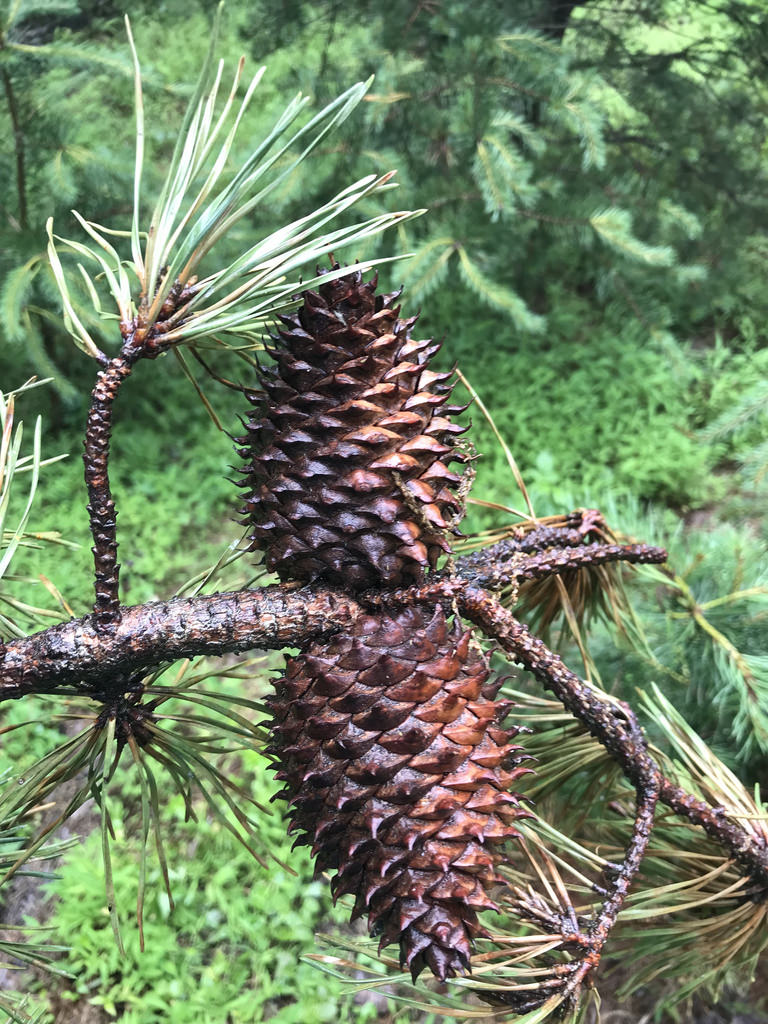Table Mountain Pine
Pinus pungens Lamb.
Description
Table Mountain pine is a small evergreen tree that usually reaches 20 to 40 feet at maturity with a trunk that reaches up to 24 inches in diameter. The trunk can be straight to crooked giving the tree an irregular shape.¹ They have many branches and keep these limbs on over half of the trunk of the tree.² The bark is red-brown to gray and has scaly plates. The needle leaves are in bundles of two to three and persist for three years. The needles are slightly twisted and grow to be 1.5 to 3.5 inches long and are yellow green in color.³ The male cones, or pollen cones, are yellow and 0.6 inches long with an oval or ellipsoid shape. Table Mountain pine trees also release their pollen earlier than other nearby pine species, which keeps hybridization to a minimum. 1,4 The seed, or female cones develop in whorls of two to seven cones per branch and can be 1.7 to 4.1 inches long.² The cones are dark brown with pronounced upwardly curving spines on each cone scale and persist on the tree. ³ These cones are serotinous, meaning that the seeds are sealed inside until they are exposed to an elevated temperature, usually caused by a fire.4

Bark and trunk of Table Mountain pine. @ B. Hubick*, Maryland Biodiversity 5

Seed cones of Table Mountain pine. @ J. Brighton*, Maryland Biodiversity Project 5
Distribution
The Table Mountain has a relatively small range, limited to the central Appalachian Mountains, from Pennsylvania to Georgia. These trees grow in the mountains at elevations of 1,500 to 4,300 feet above sea level. At these elevations the Table Mountain pine prefers to live in dry, sandy or rocky soils, often on ridges or the edge of gorges1,4 . This tree is shade intolerant, but drought tolerant, and is often called a pioneer tree. Stands are often established after an environmental disturbance like a fire. ² In Maryland, there have been observations of the Table Mountain pine in Frederick, Montgomery, and Allegany counties. 6 .

The native range of Table Mountain pine – E. Little, USGS Wikipedia12
Wildlife Importance
The cones of the Table Mountain pine persist on the tree for years, so they are available as a source of food to wildlife at any point in the year. The spines protect the cones, but animals such as the American red squirrel will often break branches off the tree to access the cones and the seeds within. This tree is also used by squirrels and other animals as shelter. ² It serves as a host to different moth species including the pine needleminer moth and the Nantucket pine tip moth. 5 Table Mountain pines also protect their habitats by stabilizing the soil in the rugged and rocky areas and minimize erosion and runoff. 4 .
Economic Importance
Since these small trees grow on steep, rocky slopes, they have little commercial value. They are ill suited for timber due to their crooked stem shape. Occasionally, they are harvested for firewood fuel or logged commercially to make pulp and paper products ² Table Mountain pine can also be used as an ornamental tree due to its hardy nature and gnarled appearance. 7
Threats
As a forest ages, Table Mountain pine is often outcompeted by other slower growing trees such as oaks. 8 These pines rely on forest fires to open their cones and allow for seed dispersal, as well as the opening of the canopy. Forest fires have often been suppressed as a danger, but this has led to a decline in the population of Table Mountain pines. 9 Other threats to this tree come from various fungus and insects. Phaeolus schweinitzii, is a fungus that can cause butt and root rot, and Phellinus pini is a fungus that can cause heartrot. The southern pine beetle, Dendroctonus frontalis, can kill off stands of these trees, and the European pine sawfly, Neodiprion sertifer, can defoliate trees. 4 The cone of the Table Mountain pine is also vulnerable to the Table Mountain pine coneworm, Diorytria yatesi, whose larva kill the seeds by eating parts of the cones. ²
Interesting Facts
- Pinus pungens means sharp pointed pine in Latin, getting its name from the large spines on the cone of this tree. 9
- The oldest recorded Table Mountain pine was 232 years old. 10
- The first specimen of this tree species was recorded in 1794 near Table Rock Mountain in North Carolina, hence the source of its common name. 11
References
- American Conifer Society: Pinus pungens
- Fire Effects Information System: Pinus pungens
- Virginia Tech Dendrology: Table Mountain pine
- USDA Forest Service Silvics, Vol. 1.: Pinus pungens
- Maryland Biodiversity Project: Table Mountain pine
- Maryland Plant Atlas: Pinus pungens
- Greentec Nursery: Pinus pungens
- USDA–Threats to Forest Health: Sustaining plant communities on Table Mountain
- Alliance for the Chesapeake Bay–Species Spotlight: Table Mountain pine
- The Gymnosperm Database: Pinus pungens
- Smokey Mountain News: Table Mountain pine
- Wikipedia: Table Mountain pine
* Imaged used with permission of photographer.
